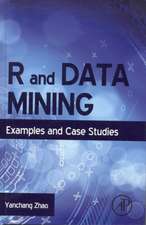Statistics for Political Analysis: Understanding the Numbers
Autor Theresa Marchant-Shapiroen Limba Engleză Paperback – 17 mar 2014
Preț: 923.86 lei
Preț vechi: 1015.23 lei
-9% Nou
Puncte Express: 1386
Preț estimativ în valută:
176.80€ • 183.90$ • 145.96£
176.80€ • 183.90$ • 145.96£
Carte tipărită la comandă
Livrare economică 14-28 aprilie
Preluare comenzi: 021 569.72.76
Specificații
ISBN-13: 9781452258652
ISBN-10: 1452258651
Pagini: 496
Dimensiuni: 187 x 232 x 17 mm
Greutate: 0.73 kg
Ediția:Revised.
Editura: SAGE Publications
Colecția CQ Press
Locul publicării:Washington DC, United States
ISBN-10: 1452258651
Pagini: 496
Dimensiuni: 187 x 232 x 17 mm
Greutate: 0.73 kg
Ediția:Revised.
Editura: SAGE Publications
Colecția CQ Press
Locul publicării:Washington DC, United States
Cuprins
1. The Political Use of Numbers: Lies and Statistics
The Power of Numbers
The Science of Politics
Introductory Statistics: An Overview
Removing the Barriers to Understanding How Statistics Works
The Importance of Statistics: This Book’s Approach
Using Data to Answer a Question
A Political Application: Indoctrination U.
Your Turn: Using Statistics
Apply It Yourself: Assess Grants to Political Scientists
Key Terms
2. Measurement: Counting the Biggel-Balls
Finding Your Cases
Measure an Attribute
Evaluate the Conceptual and Operational Definitions
Translate Information in Numbers: Coding Your Data
Get a Frequency Distribution
Summarizing the Process: Measurement
Use SPSS to Answer a Question with Measurement
Your Turn: Measurement
Apply It Yourself: Measure the Norm for Chief Justice Appointments
Key Terms
3. Measures of Central Tendency: That’s Some Mean Baseball
Measures of Central Tendency
Summarizing the Math: Averages
Use SPSS to Answer a Question with Averages
Your Turn: Measures of Central Tendency
Apply It Yourself: Calculate the Percent of Earned Income
Key Terms
4. Measures of Dispersion: Missing the Mark
Ranges
Distance from Mean
Summarizing the Math: Dispersion
Use SPSS to Answer a Question with Measures of Dispersion
Your Turn: Measures of Dispersion
Apply It Yourself: Evaluate Graduates’ Salaries
Key Terms
5. Continuous Probability: So What’s Normal Anyway?
The Normal Curve
Z-Scores
Finding a Z-Score
Use Probability to Calculate Z-Scores
Summarizing the Math: Probabilities of Continuous Events
Use SPSS to Answer a Question with Continuous Probability
Your Turn: Continuous Probability
Apply It Yourself: Evaluate the Murder Rate
Key Terms
6. Means Testing: Sampling a Population
Type I and Type II Errors
Means Testing
Confidence Intervals: Two-Tailed Distributions
Choose a Sample Size
Summarizing the Math: Sampling a Population
Use SPSS to Answer a Question with Means Testing
Your Turn: Means Testing
Apply It Yourself: Assess Maternal Mortality Rate Increases
Key Terms
7. Hypothesis Testing: Examining Relationships
Hypothesis Testing
Summarizing the Math: Hypothesis Testing and ANOVA
Use SPSS to Answer a Question with ANOVA
Your Turn: Hypothesis Testing
Apply It Yourself: Examine Partisanship’s Affect on Feelings toward the Democratic Party
Key Terms
8. Describing the Pattern: What Do You See?
Choosing the Appropriate Form of Presentation
Graphs: Relationships and Scales
Visualizing a Relationship: Contingency Tables
Summarizing the Math: Graphs and Contingency Tables
Use SPSS to Answer a Question Using a Contingency Table
Your Turn: Describing the Pattern
Apply It Yourself: Determine Stability across Legislative Systems
Key Terms
9. Chi-Square and Cramer’s V: What Do You Expect?
The Probability of Discrete Events
Chi-Square
Cramer’s V
Summarizing the Math: Chi-Square and Cramer’s V
Use SPSS to Answer a Question with Chi-Square and Cramer’s V
Your Turn: Chi-Square and Cramer’s V
Apply It Yourself: Analyze Data by Type
Key Terms
10. Measures of Association: Making Connections
Basic Principles of Measures of Association
Pearson’s R
Gamma
Lambda
Summarizing the Math: Measures of Association
Use SPSS to Answer a Question with Measures of Association
Your Turn: Measures of Association
Apply It Yourself: Measure Poor Student Graduation Rates
Key Terms
11. Multivariate Relationships: Taking Control
Spurious Relationships
Interaction Effects
Three-Way Contingency Tables
Summarizing the Process: Setting Up Three-Way Contingency Tables
Use SPSS to Answer a Question with a Three-Way Contingency Table
Your Turn: Multivariate Relationships
Apply It Yourself: Analyze Data on Race for Partisanship and Income
Key Terms
12. Bivariate Regression: Putting Your Ducks in a Line
Graph a Relationship
Fit the Data with the Ordinary Least Squares Estimate of the Line
Find the Statistical Significance
Find the Strength of the Relationship
Use Regressions with Time Series Data
Interpret Regressions with Dichotomous Independent Variables
Summarizing the Math: Regression
Use SPSS to Answer a Question with Bivariate Regression
Your Turn: Bivariate Regression
Apply It Yourself: Analyze Influences on Corruption
Key Terms
13. Multiple Regression: The Final Frontier
Using Regression to Control for Other Variables
The Assumptions of Regression
Summarizing the Process: Multiple Regression
Use SPSS to Answer a Question with Multiple Regression
Your Turn: Multiple Regression
Apply It Yourself: Evaluate the Impact of Multiple Factors on the 2012 Presidential Election
Key Terms
14. Understanding the Numbers: Knowing What Counts
Measurement
Univariate Statistics
Multivariate Statistics
Keeping the Numbers Meaningful
Embracing the Uncertainty
Key Terms
Reference Materials
Notes
Glossary
Index
The Power of Numbers
The Science of Politics
Introductory Statistics: An Overview
Removing the Barriers to Understanding How Statistics Works
The Importance of Statistics: This Book’s Approach
Using Data to Answer a Question
A Political Application: Indoctrination U.
Your Turn: Using Statistics
Apply It Yourself: Assess Grants to Political Scientists
Key Terms
2. Measurement: Counting the Biggel-Balls
Finding Your Cases
Measure an Attribute
Evaluate the Conceptual and Operational Definitions
Translate Information in Numbers: Coding Your Data
Get a Frequency Distribution
Summarizing the Process: Measurement
Use SPSS to Answer a Question with Measurement
Your Turn: Measurement
Apply It Yourself: Measure the Norm for Chief Justice Appointments
Key Terms
3. Measures of Central Tendency: That’s Some Mean Baseball
Measures of Central Tendency
Summarizing the Math: Averages
Use SPSS to Answer a Question with Averages
Your Turn: Measures of Central Tendency
Apply It Yourself: Calculate the Percent of Earned Income
Key Terms
4. Measures of Dispersion: Missing the Mark
Ranges
Distance from Mean
Summarizing the Math: Dispersion
Use SPSS to Answer a Question with Measures of Dispersion
Your Turn: Measures of Dispersion
Apply It Yourself: Evaluate Graduates’ Salaries
Key Terms
5. Continuous Probability: So What’s Normal Anyway?
The Normal Curve
Z-Scores
Finding a Z-Score
Use Probability to Calculate Z-Scores
Summarizing the Math: Probabilities of Continuous Events
Use SPSS to Answer a Question with Continuous Probability
Your Turn: Continuous Probability
Apply It Yourself: Evaluate the Murder Rate
Key Terms
6. Means Testing: Sampling a Population
Type I and Type II Errors
Means Testing
Confidence Intervals: Two-Tailed Distributions
Choose a Sample Size
Summarizing the Math: Sampling a Population
Use SPSS to Answer a Question with Means Testing
Your Turn: Means Testing
Apply It Yourself: Assess Maternal Mortality Rate Increases
Key Terms
7. Hypothesis Testing: Examining Relationships
Hypothesis Testing
Summarizing the Math: Hypothesis Testing and ANOVA
Use SPSS to Answer a Question with ANOVA
Your Turn: Hypothesis Testing
Apply It Yourself: Examine Partisanship’s Affect on Feelings toward the Democratic Party
Key Terms
8. Describing the Pattern: What Do You See?
Choosing the Appropriate Form of Presentation
Graphs: Relationships and Scales
Visualizing a Relationship: Contingency Tables
Summarizing the Math: Graphs and Contingency Tables
Use SPSS to Answer a Question Using a Contingency Table
Your Turn: Describing the Pattern
Apply It Yourself: Determine Stability across Legislative Systems
Key Terms
9. Chi-Square and Cramer’s V: What Do You Expect?
The Probability of Discrete Events
Chi-Square
Cramer’s V
Summarizing the Math: Chi-Square and Cramer’s V
Use SPSS to Answer a Question with Chi-Square and Cramer’s V
Your Turn: Chi-Square and Cramer’s V
Apply It Yourself: Analyze Data by Type
Key Terms
10. Measures of Association: Making Connections
Basic Principles of Measures of Association
Pearson’s R
Gamma
Lambda
Summarizing the Math: Measures of Association
Use SPSS to Answer a Question with Measures of Association
Your Turn: Measures of Association
Apply It Yourself: Measure Poor Student Graduation Rates
Key Terms
11. Multivariate Relationships: Taking Control
Spurious Relationships
Interaction Effects
Three-Way Contingency Tables
Summarizing the Process: Setting Up Three-Way Contingency Tables
Use SPSS to Answer a Question with a Three-Way Contingency Table
Your Turn: Multivariate Relationships
Apply It Yourself: Analyze Data on Race for Partisanship and Income
Key Terms
12. Bivariate Regression: Putting Your Ducks in a Line
Graph a Relationship
Fit the Data with the Ordinary Least Squares Estimate of the Line
Find the Statistical Significance
Find the Strength of the Relationship
Use Regressions with Time Series Data
Interpret Regressions with Dichotomous Independent Variables
Summarizing the Math: Regression
Use SPSS to Answer a Question with Bivariate Regression
Your Turn: Bivariate Regression
Apply It Yourself: Analyze Influences on Corruption
Key Terms
13. Multiple Regression: The Final Frontier
Using Regression to Control for Other Variables
The Assumptions of Regression
Summarizing the Process: Multiple Regression
Use SPSS to Answer a Question with Multiple Regression
Your Turn: Multiple Regression
Apply It Yourself: Evaluate the Impact of Multiple Factors on the 2012 Presidential Election
Key Terms
14. Understanding the Numbers: Knowing What Counts
Measurement
Univariate Statistics
Multivariate Statistics
Keeping the Numbers Meaningful
Embracing the Uncertainty
Key Terms
Reference Materials
Notes
Glossary
Index
Notă biografică
Descriere
This book focuses on the statistical tools most often used by political scientists and uses political examples, cases, and data throughout to show students how to answer real questions about politics using real political data.










